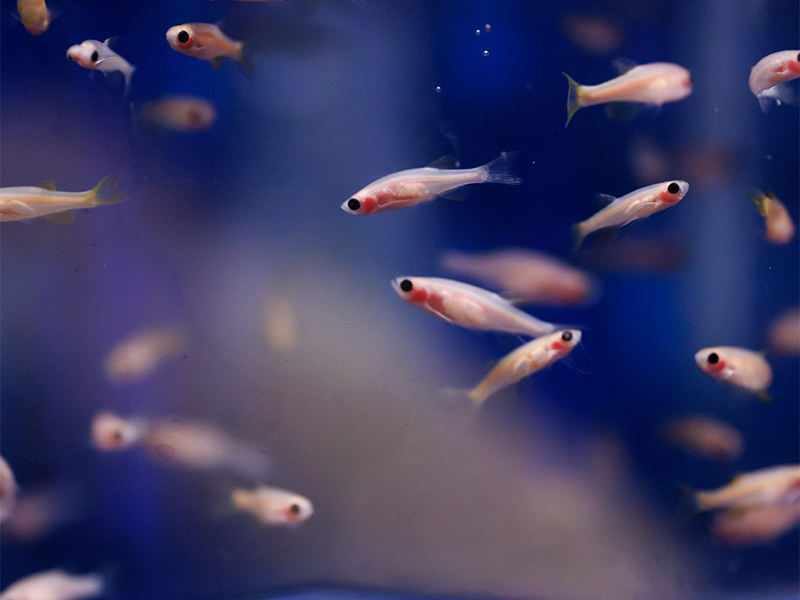
Research
- Department of Cell and Molecular Biology Home
- About the Department
- Education
- Research
- Contact Cell and Molecular Biology
- Support the Department of Cell and Molecular Biology
- Support the Center for Immunology and Microbial Research and the Graduate Program in Microbiology and Immunology
Zebrafish Core Facility

Aim:
The aim of the University of Mississippi Medical Center Zebrafish Core Facility is to provide the Department of Cell and Molecular Biology and the greater UMMC community with zebrafish embryos, larvae and adult zebrafish for research and be a technical resource.
Why use zebrafish as a model organism?
- Molecular and pathological conservation with humans
- Ability to produce a large progeny (1 breeding pair, approximately 200 embryos)
- Imaging capacity
- Large scale chemical and pharmacology testing in vivo
- Ease of genetic manipulation
The Facility
The Cell and Molecular Biology Zebrafish Core Facility is a 1,200 sq.ft. space housing a state-of-the-art Tecniplast. The facility also has more lab space dedicated to animal work in an adjacent building, the Clinical Science Building. Altogether, the zebrafish facilty has an extra 1,160 square feet of space in the building. Currently, the facility has a state-of-the-art 750 Tecniplast tanks including a quarantine rack (80 tanks) and a nursery. The laboratory dedicated to the fish facility is equipped for several routine animal procedures such as: surgery, imaging, screening, euthanasia and storage. The different zebrafish lines are raised in-house at the UMMC zebrafish facility and maintained as live colonies.
Personnel
- Director: Nicole Anderson, PhD
Assistant Professor, Department of Cell & Molecular Biology - Zebrafish Technician: Jackson Boone
Researcher II
Models
| Table 1. Zebrafish Lines Available in ZCF | ||
|---|---|---|
| Name | Type | Description |
| bm3c(pou4f3)-GFP | Lineage Marker | cilia marker - Green |
| CD41-GFP | Lineage Marker | platelet marker - Green |
| ctsk-GFP | Lineage Marker | Osteoclast - Green |
| dbh:EGFP | Lineage Marker | Peripheral Sympathetic Neuron Marker - Green |
| dbh:mCherry | Lineage Marker | Peripheral Sympathetic Neuron Marker - Red |
| dlx2b-GFP | Lineage Marker | Tooth germ marker - Green |
| fli1-GFP | Lineage Marker | Vascular Endothelium - Green |
| kdr1:mCherry | Lineage Marker | Vascular Endothelium - Red |
| lyz-mCherry/mpeg1:GFP | Lineage Marker | Neurophil (Red)/Macrophage (Green) |
| mngf7-GFP | Lineage Marker | peripheral nerve marker - Green |
| mpeg-GFP | Lineage Marker | Microglia |
| sp7-GFP | Lineage Marker | Osteoblast - Green |
| wt1-GFP | Lineage Marker | pronephros - Green |
| rag2:mCherry | Lineage Marker | T-cells - Red |
| rag2:EGFP | Lineage Marker | T-cells - Green |
| acetyl CoA cartoxylase a (ENU) | Mutant | Loss-of-function |
| blvra (CRISPR) | Mutant | Loss-of-function |
| blvrt (CRISPR) | Mutant | Loss-of-function |
| Casper | Mutant | Transparent Adult |
| CB1 (CRISPR) | Mutant | Loss-of-function |
| CB2 (CRISPR) | Mutant | Loss-of-function |
| coilin KO (CRISPR) | Mutant | Loss-of-function |
| coilin C-termunus (CRISPR) | Mutant | coilin hypomorph |
| ERR Gamma a (CRISPR) | Mutant | Loss-of-function |
| higd1a (CRISPR) | Mutant | Loss-of-function |
| higd2a (CRISPR) | Mutant | Loss-of-function |
| p53mut (M214K) | Mutant | p53 hypomorph |
| PPAR gamma (CRISPR) | Mutant | Loss-of-function |
| runx2b (ENU) | Mutant | Loss-of-function |
| dbh:ALK_F1174L | Transgenic | Expression of Activated ALK in PSN |
| MYCN_TT (tg(dbh:EGFP);tg(dbh:Hsa.MYCN) | Transgenic | Neuroblastoma Model |
| MYCN (tg(dbhEGFP-Hsa.MYCN):tg(mitfa:mitfa) | Transgenic | Neuroblastoma Model |
| LMO1(tg(dbh:Hsa.LMO1);Tg2(dbh:mCherry) | Transgenic | LMOl Over Expression in PSN |
| AML1-ETO | Transgenic | AMLl ETO t(8,21) model |
| Tg(fabp10a:pt-beta-eatenin) | Transgenic | HCC model |
| AB | Wildtype Strain | |
| TL | Wildtype Strain | |
Inquiries
For general inquiries, please contact the facility at zebrafishcore@umc.edu
For specific research-related questions, please reach out to Dr. Nicole Anderson to collaborate with us and use our in-house zebrafish strains.


